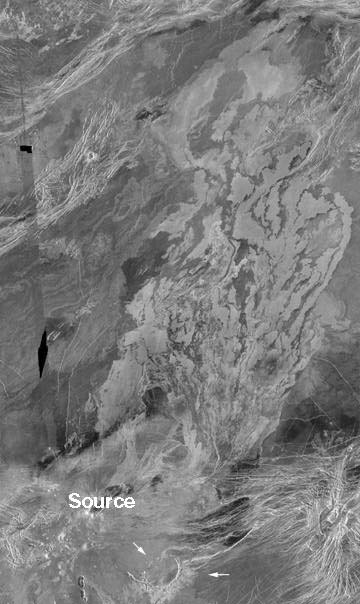Large Lava Flow Features

REFERENCE MAP (Channels, Flows, Calderas)
Large liquid lava flows are thought to form three types of feature on Venus. The
first are large, flood-like lava flow fields or fluctus. The second are long lava
channels. And the third are large calderas that have no clear shields or cones. None
of these features are common on Venus, but they are still plentiful and several large
examples of each type are known.
Large Flows
The map above shows the locations of some 53 lava flood fields.
These flow fields are mostly 100 to 700 km long, but the longest are over 1000 km in
length. Their widths are variable, but can reach over 300 km. In size, they are thus
much like lava flood basalts on the Earth, and like the youngest mare flows on the
Moon. They mostly lie near the edges of the lowland plains, and flow down into
these plains. A few are located near younger large shields, but many lie at some
distance from the largest shield volcanoes. It is thought that these flows may have
formed near the end of plains formation.
Lava Channels
In all nearly 200 channels have been found on Venus. Many of
these channels lie in the lava flood fields or on other volcanoes. Still, nearly 50 lava
channels have been found which do not lie on a larger lava flow. These channels
are usually 0.5 to 1.5 km wide, but they range widely in length. Most are less than
400 km long, but some are over 700 km long. One is longer than every other known
lava channel in the solar system. With a length of about 6800 km (~4200 miles), this
one channel is even longer than the Nile River on Earth.
Like the Lava Flood Fields, most lava channels start near the edges of the
lowland plains. Many are also found near coronas or in large groups. In general, the
lava channels on Venus look much like sinuous rilles on the Moon. The longest
channels, however, are not quite the same. First, they tend to be straighter and wider
than the lunar rilles. Second, some show older branches and cut-off loops like those
in large rivers on Earth. This suggests that some of these channels may have formed
over a long time from one or more eruptions.
Calderas
The last features mapped here mark sites from which large volumes
of lava are believed to have erupted. These calderas are large, round to oval pits that
have steep walls but very low rims. They are often surrounded by a ring of faults or
graben. Calderas are thought to form when the ground falls in over an emptied,
shallow magma chamber. Although part of many shield volcanoes, 86 calderas
have also been found on Venus which are not. Most of these calderas are between 40
and 80 km in size, but the largest are nearly 200 km across. Most are near the shields
of Atla and Beta Regio, but a few also lie in the high plains of Lakshmi Planum.
Almost no calderas are found in the lowland plains. This lack suggests that
shallow magma chambers did not form in the lowlands. If this is true, then lavas
must have risen straight to the surface there. Thus, the lavas would have little
chance to pool together or to build up in a single area over time. This could explain
both plains formation and the small sizes of the lowland shields. In the highlands,
however, we find both calderas and large shields. Thus, shallow magma chambers
could form higher up.
This change in volcanism with height is thought to be an
effect of air pressure. In the lowlands, air pressures are very high, nearly 100 times
those on Earth. Thus, lowland lavas are much like seafloor lavas on Earth. They are
very dense and contain almost no gas bubbles. In the highlands, air pressures are
lower, and this lets some gas bubbles form on eruption. This makes highland rocks
less dense and can allow lavas to pool below the surface. If the lavas pool in one
place over many eruptions, then a large shield can be built up over time. However,
no such build up can occur if the pool does not fill up again after the eruptions.
Instead, a caldera should form like those mapped here.

Venus Volcanoes
To VolcanoWorld